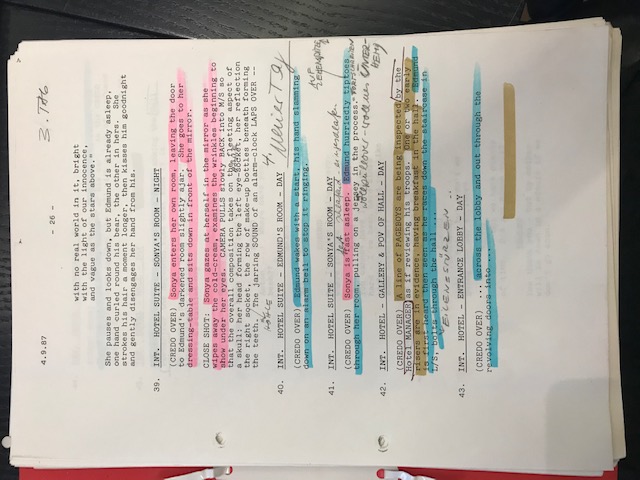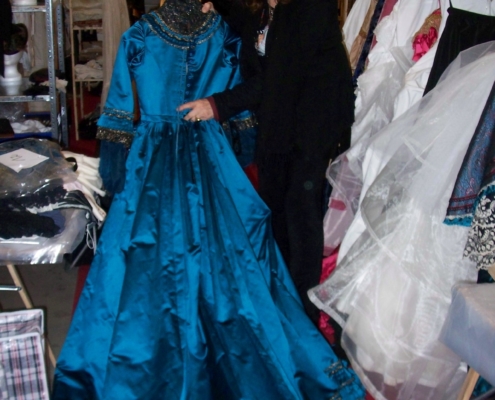This display case contains work material from the three films Fathers and Sons, Burning Secret and Buddenbrooks.
First, some background information on Fathers and Sons. This TV miniseries from 1984/85 follows the rise and fall of the fictitious Deutz family and their paint and tar factory – which grew into the company IG Farben and became a cog in the Nazi killing machine. Filming locations for the series included Munich, Heidelberg and Prague. Monika Jacobs supported Barbara Baum in this project as her assistant. Some of the costumes were made at the Theaterkunst costume workshop in Berlin. Materials relating to this TV drama are displayed in the left-hand section of the case. In the top left are two photos: one shows Barbara Baum in a train compartment being made up as an extra. She is wearing a light-colored outfit, accessorized in the second photo with a wide-brimmed, elegant sun hat. To the right of these photos are some perforated and bound A4 sheets featuring a handwritten note that says: “Shooting schedule for Geheimrat Deutz Burt Lancaster from March 15, 1985.” Next to this are two color photos of Laura Morante and Katharina Thalbach, both in elegant evening gowns. There is also a newspaper clipping from the German paper Die Zeit dated November 21, 1969, with the headline “A Family from Essen” and a black-and-white photograph of the Krupp family, which Baum used as research material. Displayed in a folder is a historical photo of a family member of the director, Sinkel: an elderly gentleman with white hair, a white mustache and glasses with round lenses. On the left, roughly in the middle, is a list of Burt Lancaster’s measurements. Next to this on the right is a spiral-bound notebook showing a sketch for the ice-blue dress and a photograph of Julie Christie wearing the garment. This is followed by fabric samples for the men’s suits in shades of gray and brown plus receipts from the purchase of accessories, including shoes, hats and an orthopedic corset. The latter was intended to make Christian Körner “somewhat thinner” for the scene where he gives his statement at the Nuremberg Trials. At the bottom are photos taken on set: two show Julie Christie in her gold lamé dress and one is a black-and-white family photo, with Burt Lancaster sat in the middle.
The middle section of the display case contains materials from Burning Secret – a movie adaptation of a Stefan Zweig novel. One of Barbara Baum’s biggest challenges with this project was convincing Faye Dunaway of her costume ideas. Baum travelled to New York, showed the actress her designs and took her along to specialist retailer stores. This marked the beginning of a wonderful collaboration. The designer would go on to receive a Golden Osella for Best Costume Design at the 1988 Venice International Film Festival.
The focal point of the display is a sketchpad, around which several other documents are displayed. The sketch is of Baum’s design for the red dinner dress worn by Faye Dunaway in her role as Sonya. The dress is sketched from the front and the back. A color photo displays Faye Dunaway wearing the finished garment.
Above the sketch is the first page of the costume plot, with handwritten on lined paper. A costume plot is created on the basis of the screenplay and is required for every main character. On page 26 of the screenplay, to the left of the costume plot, colored markings have been made: in pink for Sonya, blue for Edmund, and yellow for the extras. Baum has noted down the costumes that will be required scene by scene – depending on the time of day, season, and whether it is set inside or outside. Following on clockwise, research materials are displayed in the form of drawings and photographs – including those of children’s clothing from the 1910s. These are accompanied by Baum’s correspondence with make-up artist Jane Carvell regarding the coordination of accessories and hairstyles. Following on is a list of some of the costume purchases, including shoes and jewelry. Attached to the list is a photo of Faye Dunaway sitting on an antique sofa wearing a black velvet coat with a wide white-and-gray fur collar made from Russian squirrel.
In the right-hand section of the display case are materials relating to Barbara Baum’s work on the film Buddenbrooks. Buddenbrooks is a movie remake of the Thomas Mann novel of the same name, which tells of the rise and fall of a German merchant family at the dawn of the modern era. The costumes were made in Berlin, London and Rome. In Rome, Barbara Baum discovered fabrics from Visconti’s 1963 movie IL GATTOPARDO (The Leopard), which she was given permission to use for Gerda’s red ball gown. At the top are prints from the costume plot for Tony Buddenbrook (played by Jessica Schwarz) and a costume list with handwritten notes for the role of Gerda. Underneath is Barbara Baum’s copy of the screenplay, with costume plot markings for the individual characters. The title page is displayed separately to the left of the screenplay. On it, Baum has written “my screenplay” inside a stylized little tree – her trademark doodle. The costume list is compiled using the costume plots and lists all the costumes required for each role – including the calculated costs for making, purchasing or renting these garments. Displayed in the top right is the sketched design of a men’s shoe for Mark Waschke (who plays Thomas Buddenbrook) together with leather samples. To the right of this are photos from the movie set in Cologne, showing heavily laden clothes rails in large halls and a full rack of shoes – including those made for Mark Waschke. In another photo, Barbara Baum presents Gerda’s peacock blue dress. Four photos show Barbara Baum putting the finishing touches to the costumes once they are on the actors. In one photo she squats behind Iris Berben, in the role of Bethsy, straightening her long, off-the-shoulder gown.
Barbara Baum on working with Heinrich Breloer on Buddenbrooks





























